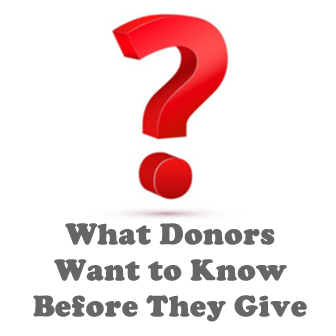A friendly smile, and a few words about your group’s cause may be enough when it comes to selling products at a fair or offering a gift wrapping service around the holidays.
But how can you convince donors to give more than just a few dollars? What kind of information should you make readily available and how should you present it? What would donors like to know before they’re willing to make a larger donation?
Following are a few points to consider before asking a donor to give:
Relevance:
Is your group relevant in a way that it makes a real difference in society? Unless you’re raising funds for an individual or a specific short term goal, does your group affect a larger group of people? If a potential donor feels that your cause isn’t really needed they will not come forth with support.
If the group benefiting from your cause is somewhat limited, it is especially important to lay out all the good that you’re doing in a way that shows how your cause doesn’t just benefit a seemingly small group of people, but how it benefits the community as a whole. In other words, spend some time explaining the big picture. After all, helping the disadvantaged or needy within a group doesn’t just benefit them, there is always a domino effect whereas others are helped and supported as well, directly or indirectly.
Activities and people:
Does your group have a blog? Do you regularly report about your activities and how you make a difference in your community and in the world? This plays right into the previous point: if you continuously report on your activities and the good you do, your cause will become much more relevant to potential donors. And don’t think you should only report on successes. By also writing about the challenges you face every day, your cause goes from being just words to becoming a group of individuals working hard to make a difference in the world.
If you do have a blog (or other website) make sure you include proper terms of use and a privacy policy which includes information about how you manage names, email addresses, and other information collected through the site. Your website is also an excellent place to add information about your board members, staff and volunteers.
A well run website or blog with lots of information about your activities, staff and volunteers will give your supporters a broad picture of what your group is all about. Be sure to continuously update your site.
(If you need a website with or without a blog, read Create A Website.)
Financials:
Are you clearly stating your financial information on your website and in print documents meant for interested parties? If your financial information is too hard to find or to decipher and a potential donor feels that you might not want to share them, it will be a turnoff. Make your finances easy to access and explain your numbers. Also display and link to your most recently filed IRS Form 990.
If some expenses seem high, explain why they’re high: maybe you’ve incurred a higher outlay because of a major repair. If you explain that donor money wasn’t wasted, but why some program, administrative or fundraising expenses turned out higher than expected, most donors will appreciate your honesty. If the extra expenses are justified, they will still give.
If your group is a registered non-profit, have all your reports been properly filed? Can supporters go to a third party website to find out more about your group if they choose? Simply staying on top of tasks you’re supposed to do anyway will make a difference and will give you an edge over others who don’t have their accounting in order.
Information on the web:
Have you googled your cause to see what kind of information comes up? Your own website’s pages and your social media accounts should be among the search results on the first page. (Another reason to have a blog, Twitter and Facebook accounts.) Potential donors are very likely to research your cause on the web, so make sure the information on the result pages is accurate and the pages look professional.
Also regularly check your information on charity rating or watchdog sites to make sure your information is accurate: CharityNavigator.org, BBB Wise Giving Alliance, Guidestar.org, Guidestar.org – most effective list, CharityWatch.org, CharityWatch.org – top rated.
Even if your cause is not listed on these sites yet, take a look at some of the highest rated non-profits’ websites in your category. What kind of information do they offer through their site and how do they organize it?
Your to-do-list:
Maybe you already have some or most of these points in place – congratulations! Then you could simply make a to-do list of what kind of other information you’d like to add to your website and marketing materials and how you’d like to change the way your information is currently presented. Be sure you add information about what you’d like staff and volunteers to say when prompted about your cause. What are they currently telling potential and current supporters? Is the information they have about your cause up-to-date and relevant?
Also think about your own giving: Which organizations have you donated to in the past and why? Or why have you decided not to give a specific group? Take these clues from your own behavior and consider them in your group’s strategy.
By making sure you offer enough and sought-after information about your cause you instill a sense of trust in your supporters and assure that they feel comfortable and confident giving to your cause now and in the future.

